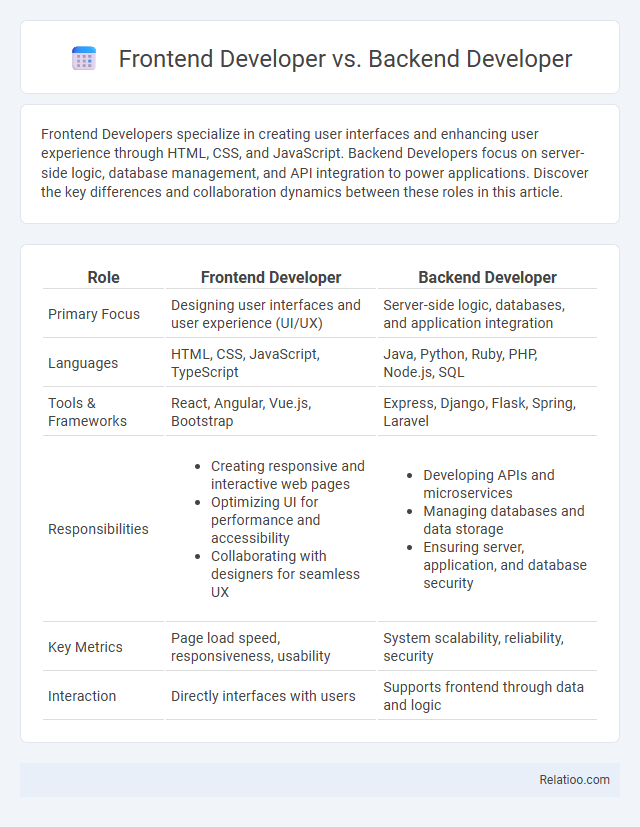Frontend Developers specialize in creating user interfaces and enhancing user experience through HTML, CSS, and JavaScript. Backend Developers focus on server-side logic, database management, and API integration to power applications. Discover the key differences and collaboration dynamics between these roles in this article.
Table of Comparison
| Role | Frontend Developer | Backend Developer |
|---|---|---|
| Primary Focus | Designing user interfaces and user experience (UI/UX) | Server-side logic, databases, and application integration |
| Languages | HTML, CSS, JavaScript, TypeScript | Java, Python, Ruby, PHP, Node.js, SQL |
| Tools & Frameworks | React, Angular, Vue.js, Bootstrap | Express, Django, Flask, Spring, Laravel |
| Responsibilities |
|
|
| Key Metrics | Page load speed, responsiveness, usability | System scalability, reliability, security |
| Interaction | Directly interfaces with users | Supports frontend through data and logic |
Introduction to Frontend and Backend Development
Frontend development focuses on creating the user interface and experience by using technologies like HTML, CSS, and JavaScript to build visually appealing and interactive websites or applications. Backend development involves managing server-side logic, databases, and application integration with languages such as Python, Java, and SQL to ensure data processing, security, and functionality behind the scenes. Your choice between frontend, backend, or full-stack development depends on whether you prefer designing the visible parts that users interact with or handling the underlying systems that power those interfaces.
Key Roles and Responsibilities
Frontend Developers specialize in designing and implementing user interfaces using HTML, CSS, and JavaScript, ensuring a seamless and responsive user experience. Backend Developers handle server-side logic, database management, and API integration, focusing on application performance, security, and scalability. As a Developer, you may need a comprehensive understanding of both frontend and backend roles to effectively manage full-stack development and deliver cohesive software solutions.
Essential Skills and Technologies
Frontend Developers specialize in HTML, CSS, JavaScript, and frameworks like React or Angular to create visually appealing, user-friendly interfaces. Backend Developers excel in server-side languages such as Python, Ruby, or Java, and work with databases like MySQL or MongoDB to build scalable, secure application logic. Your choice between Frontend, Backend, or Full-Stack Developer roles depends on mastering these essential skills and technologies aligned with project needs.
Core Programming Languages Used
Frontend developers primarily use HTML, CSS, and JavaScript frameworks like React or Angular to create interactive user interfaces and ensure responsive design. Backend developers rely on languages such as Python, Java, Ruby, PHP, and server-side frameworks to manage databases, server logic, and application integration. A general developer often possesses a versatile skill set that includes both frontend and backend languages, enabling full-stack development and seamless communication between user-facing and server-side components.
Tools and Frameworks Comparison
Frontend Developers primarily utilize tools and frameworks like React, Angular, and Vue.js to build user interfaces, emphasizing responsive design and interactivity. Backend Developers focus on server-side technologies such as Node.js, Django, Ruby on Rails, and databases like PostgreSQL or MongoDB to manage data processing, APIs, and application logic. Your choice between frontend, backend, or full-stack development depends on your interest and proficiency in specific tools, frameworks, and the structure of applications you want to create.
Typical Daily Tasks and Workflows
Frontend Developers specialize in creating user interfaces, focusing on HTML, CSS, and JavaScript to design responsive layouts and improve user experience by implementing interactive elements and optimizing performance. Backend Developers manage server-side logic, databases, and application integration, often working with languages like Python, Java, or Node.js to ensure data security, scalability, and efficient processing. Your role as a Developer may involve combining both frontend and backend tasks, collaborating closely with cross-functional teams to streamline workflows, troubleshoot issues, and deploy full-stack solutions.
Career Pathways and Opportunities
Frontend developers specialize in building user interfaces with skills in HTML, CSS, and JavaScript, opening career pathways in UX/UI design or full-stack development. Backend developers focus on server-side logic, databases, and APIs using languages like Python, Java, or Node.js, offering opportunities in system architecture and cloud engineering. Your choice between frontend, backend, or general developer roles influences career growth, specialization, and the tech industry sectors you can excel in.
Salary Expectations and Job Market Trends
Frontend Developers command competitive salaries due to their expertise in user interface technologies like HTML, CSS, and JavaScript, with average annual earnings ranging from $70,000 to $110,000 depending on experience and location. Backend Developers focused on server-side programming languages such as Python, Java, or Node.js typically earn between $80,000 and $120,000, reflecting the complexity and critical role of data management and system architecture. Your career choice should consider current job market trends, which show increasing demand for full-stack Developers who combine frontend and backend skills, often leading to higher salary potential and broader employment opportunities.
Collaboration in Full Stack Teams
Frontend developers specialize in creating user interfaces and ensuring seamless user experiences, while backend developers focus on server-side logic, databases, and application performance. Effective collaboration between these roles in full stack teams enhances project efficiency, as clear communication bridges client-side aesthetics with robust backend functionalities. Your ability to understand both domains encourages smoother integration and accelerates development cycles.
Choosing the Right Path for Your Career
Choosing the right path between frontend developer, backend developer, and full-stack developer depends on your interest in user interface design, server-side logic, or a blend of both. Frontend developers specialize in HTML, CSS, JavaScript frameworks like React or Angular, while backend developers focus on databases, APIs, and server languages such as Node.js, Python, or Java. Full-stack developers combine these skills, offering versatility and higher demand in job markets seeking integrated web solutions.

Infographic: Frontend Developer vs Backend Developer
 relatioo.com
relatioo.com